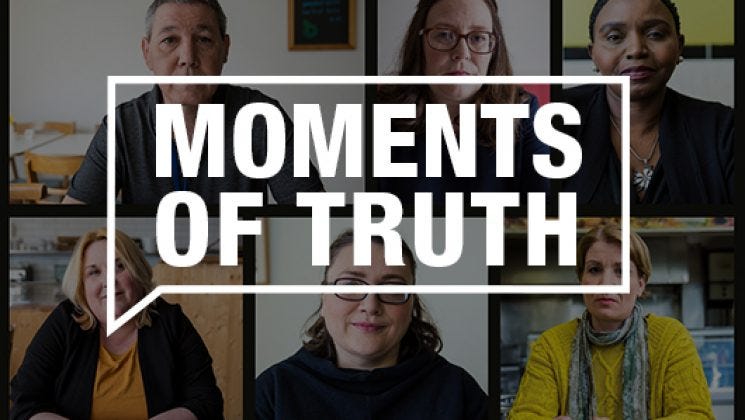We’re moving so fast - light speed at times. In customer success we have to make so many micro-decisions that at times we can operate on autopilot. Think about a recent customer interaction you had. How did you respond to it? You probably relied on instinct based on your previous knowledge or processes and policies that your company has in place. You may not remember half of what you said. In most situations, that’s fine.
But this of course doesn’t always work - especially where customers don’t agree with your response. The challenge is recognizing when you have entered a special situation. A moment when your decision will make or break your client relationship. These are what I call moments of truth. Think of these situations like the butterfly effect where a small action will change the future. I will try and help you identify these moments of truth and provide recommendations so you can act appropriately. First let me tell you about my own wakeup call.
You can make a mistake, but how will you recover?
Going back a few years now I was in the depths of hell handling several client contract negotiations during the initial stages of the Covid crisis. I will be honest here - it was one of my most challenging times as a CS leader. As it was still early in the pandemic, it was difficult to understand the impact this would have on our customers. Different customers were experiencing the pandemic differently and I had to make decisions quickly based on sparse pieces of information. The main issue was that I had too many items coming at me from all directions. It didn’t take long until I made a colossal mistake that could have had larger repercussions.
One of our clients was starting to see an uptick in their business but they needed help. They needed to add licenses to help their team so they could better assist their own customers. Moving at the speed of light I coached my customer success manager to follow our process and offer our clients a solution based on our stated policies. The challenge was that this solution didn’t fit the client’s needs and would be costly. I didn’t realize it, but I was in a moment of truth, and I failed miserably.
The client had no choice but to proceed and when the dust settled, they took the time to let me know that they weren’t happy with what transpired. They felt that we could have been more customer-centric and they were right. This was the wakeup call I needed, and I can’t express my appreciation enough to this client. After thanking them for their feedback I quickly reversed course. I obtained the necessary approvals to provide a better solution that made more sense in this situation.
Reflecting on this time, I realized that we should have pushed the pause button and considered the situation from the client’s perspective. Our policies were valid but didn’t account for the unique crisis we were in. We needed to consider the client’s business needs and go outside the lines of our established policies. This was our moment of truth and something I now constantly remind myself of.
Defining moments of truth
While I love Wayne McCulloch’s book The Seven Pillars of Customer Success, I disagree with how he defined moments of truth. He used this definition: “Anytime the customer comes into contact with any aspect of a company, however remote, he or she has an opportunity to form an impression”1. He referred to a moment of truth as any time a customer interacts with you.
My definition is different. It was something that a former executive at Eloqua, Alex Shootman, had instilled in me years ago. I define a moment of truth as: “a critical interaction in the customer journey when the action(s) your company takes will determine if the client remains a long-term customer.” Therefore, this isn’t just any type of engagement. This moment will shape the future of your customer relationship.
How do you know it’s a moment of truth?
As I mentioned, it can be challenging to realize that you are in that make or break situation with a client. Here are some signs that can tell you that you are in a moment of truth:
The customer tells you. This is the easiest situation of all to recognize because your customer will very explicitly tell you that your future relationship is hinging on how you handle the current predicament. They may also tell you that they are very upset with how a situation was handled. This could revolve around a critical bug, a missing feature, the price of a renewal or several other circumstances. In some situations, clients will bypass you and express how they feel on social media and in online communities. While it’s easy to recognize that this is a moment of truth, it’s still not easy to resolve.
In some situations, it’s recommended that someone such as a customer success manager qualify how dire the situation is. I like to use qualification questions such as: “From 1-5 with 1 being the most important, how critical is this item for you?”. In other situations, such as the story I shared, it isn’t needed. I knew my client well enough to recognize the severity of the situation and that they were right. If the client takes the time to tell you that they feel you messed up, you need to address the situation quickly and handle it delicately.
The client is very emotional. The client may not outright tell you that they will stop doing business with you, but you can tell from their mannerisms that they are unhappy or angry and at a breaking point. In these situations, it’s best to label the emotion so the client can communicate how they are feeling. For example, you can reflect on what the client said: “It seems that you are very upset”. You can then add if it makes sense: “How do you recommend we resolve this issue?”
In these situations, you need to slowwwww down so you can take in the customer’s perspectives. Ask yourself these questions:
Why is the customer feeling this way? What is impacting them or their business right now that may be causing this?
How would I want to be treated if I was the customer?
What has happened previously that may be impacting how they are reacting?
Are our current processes and policies adequate for the exact situation we’re in right now?
Is what the client is asking for unreasonable?
By asking yourself these questions you have paused long enough to turn off your autopilot and think through your actions. I also recommend going for a walk. If you have any doubts as to how you have acted or how you plan to act, pull a colleague aside and walk them through the situation. Ask them for their advice on how they would handle this. Ask them for feedback on your planned course of action. Getting a second opinion can prevent the wrong action or help get things back on track.
The client goes silent. When you are experiencing a moment of truth, you have a brief period to identify and rectify the situation. If it’s not handled correctly, you may have a client go dark on you. This is typically a clear sign that you failed to act appropriately from their perspective. It’s best to acknowledge that so you can move forward.
I had a situation where the CSM-client relationship had deteriorated but I hadn’t noticed it quickly enough. They had kept pushing off meetings and were ignoring my reach outs. I asked for a brief call and said that the conversation was of a sensitive nature and could only be done by phone.
After some additional prodding, the client agreed to meet, and I told them that we needed to do better. I recommended a path forward and asked them for their input. They agreed to my plan, and we were able to repair the relationship. This was lucky but it was only when I realized that this was a moment of truth and that I had to force the situation or risk losing the client forever.
Your moment of truth
I want you to think back again on recent conversations you’ve had with your customers or anyone for that matter. Did you face a moment of truth? How did you handle the situation? Would you approach things differently now that you saw the consequences of your actions?
Consider client relationships that may be on the rocks or past interactions that you should have handled differently. What changes can you make to rectify these situations? What changes will you make when you experience another moment of truth? This is your moment of truth. What will you do?
McCulloch, Wayne. The Seven Pillars of Customer Success: A Proven Framework to Drive Impactful Client Outcomes for Your Company (Kindle Locations 503-504). Kindle Edition.














Share this post